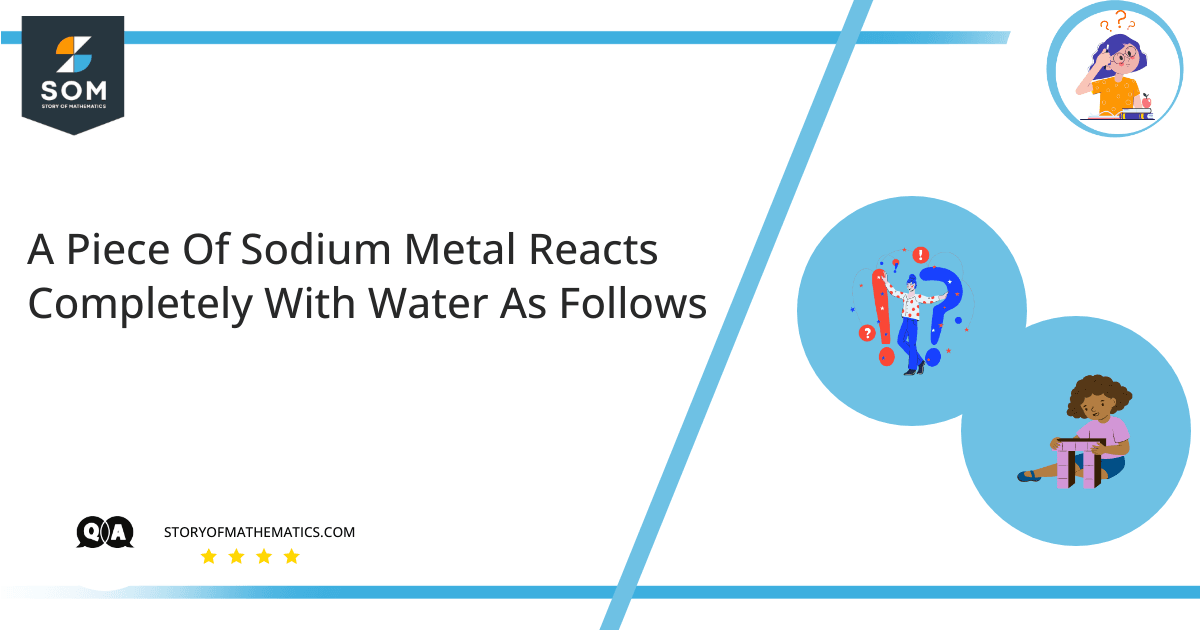
The
reaction is given as follows:\[2Na(s) +2H_{2}O \Rightarrow 2NaOH(aq) +H_{2}(g)\]This
article aims to
determine the mass of sodium used in the given reaction. The article uses the
concept of finding the number of moles and then mass from the
number of moles. Ideal gas law is used to determine the number of moles of gas.
Ideal gas law relates
pressure,
volume, the
quantity of gas,
temperature, and the
number of moles. The
ideal gas law is given as:\[PV = nRT \]
Expert Answer
Given Data:The
reaction is given as:\[2Na(s) +2H_{2}O \Rightarrow 2NaOH(aq) +H_{2}(g)\]$M_{r} = 22.99$The
temperature in Kelvin is given as:$ T = 25 ^{\circ} C = (273+25)K = 298K $$ V = 246mL = 0.246L $ is the volume of gas.$ p_{t} = 1.00 \:atm$ is the
total pressure over the water.$ R = 0.0821 \: L\:atm \:mol^{-1}\: K^{-1} $ is the
ideal gas constant.$P_{H_{2}O} = 0.0313 \: atm $ at $ 25^{\circ} C $ is the
vapor pressure of water.The
partial pressure of the hydrogen is given by:\[p_{t} = p_{H_{2}}+ p_{H_{2}O}\]\[1.00atm = p_{H_{2}} + 0.0313atm \]\[p_{H_{2}} = 0.9687 atm\]The
moles of hydrogen are given by:\[0.9687atm \times 0.246L = n \times 0.08206 L.atm.K^{-1}.mol^{-1} \times 298.15K \]\[0.2383 = n\times 24.27 mol^{-1} \]\[n =0.009740 mol\]\[Moles\:of \: Na = 0.009740\: mol\:of \: H_{2} \times \dfrac{2 \:mol\: Na }{1\:mol\:H_{2}} = 0.01948molNa \]\[Mass\: of \:Na = 0.01948molNa \times \dfrac {22.99\:g\:of \:Na }{1\:mol\:Na } = 0.449\:g\:of\:Na \]The
mass of $Na$ used was $0.449\:g$.
Numerical Result
The
mass of sodium used in the reaction is $0.449\:g$.
Example
A reaction of sodium metal with water is as follows:\[2Na(s) +2H_{2}O \Rightarrow 2NaOH(aq) +H_{2}(g)\]Hydrogen gas is gathered over water at $30.0 ^{\circ }C$. Volume of gas is $250\: mL$, measured at $1.00\: atm$. Determine the number of grams of sodium used in the reaction. (Water vapor pressure at $25$ degrees ATM.)SolutionGiven Data:The
reaction is given below:\[2Na(s) +2H_{2}O \Rightarrow 2NaOH(aq) +H_{2}(g)\]$M_{r} = 22.99$The
temperature in Kelvin is given as:$ T = 25 \circ C = (273+30)K = 303K $$ V = 250mL = 0.25L $ is the volume of gas.$ p_{t} = 1.00 \:atm$ is the
total pressure over the water.$ R = 0.0821 \: L\:atm \:mol^{-1}\: K^{-1} $ is the
ideal gas constant.$P_{H_{2}O} = 0.0313 \: atm $ at $ 25 ^{\circ} C $ is the
vapor pressure of water.The
partial pressure of the hydrogen is given by:\[p_{t} = p_{H_{2}}+ p_{H_{2}O}\]\[1.00atm = p_{H_{2}} + 0.0313atm \]\[p_{H_{2}} = 0.9687 atm\]The
moles of hydrogen are given by:\[0.9687atm \times 0.25L = n \times 0.08206 L.atm.K^{-1}.mol^{-1} \times 303K \]\[0.2422 = n\times 24.864 mol^{-1} \]\[n =0.009741 mol\]\[Moles\:of \: Na = 0.009741\: mol\:of \: H_{2} \times \dfrac{2 \:mol\: Na }{1\:mol\:H_{2}} = 0.019482molNa \]\[Mass\: of \:Na = 0.019482molNa \times \dfrac {22.99\:g\:of \:Na }{1\:mol\:Na } = 0.449\:g\:of\:Na \]The
mass of $Na$ used was $0.4478\:g$.
 The reaction is given as follows:\[2Na(s) +2H_{2}O \Rightarrow 2NaOH(aq) +H_{2}(g)\]This article aims to determine the mass of sodium used in the given reaction. The article uses the concept of finding the number of moles and then mass from the number of moles. Ideal gas law is used to determine the number of moles of gas. Ideal gas law relates pressure, volume, the quantity of gas, temperature, and the number of moles. The ideal gas law is given as:\[PV = nRT \]
The reaction is given as follows:\[2Na(s) +2H_{2}O \Rightarrow 2NaOH(aq) +H_{2}(g)\]This article aims to determine the mass of sodium used in the given reaction. The article uses the concept of finding the number of moles and then mass from the number of moles. Ideal gas law is used to determine the number of moles of gas. Ideal gas law relates pressure, volume, the quantity of gas, temperature, and the number of moles. The ideal gas law is given as:\[PV = nRT \]